
Trenchless Sewer Replacement in British Columbia:
PW Trenchless Provides Pipe Bursting Proficiency
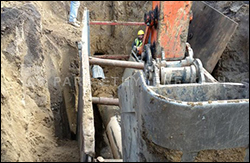
With heavy traffic flow and anticipated growth and development, the Corporation of Delta, British Colombia began upgrade work two years ago to its River Road corridor. The corridor serves as a main trucking artery and sees heavy amounts of traffic. Upgrades to the corridor include the construction of new sidewalks, traffic flow measures at several intersections, increasing lane widths to safely accommodate bicycle traffic, as well as general road repair and rebuilding.
In addition to surface improvements, the project includes the replacement of an aging sanitary sewer system. The location of the sewer main, the heavy traffic flow and existing utilities precluded the use of conventional open cut methods. A trenchless solution was needed. PW Trenchless, Surrey, BC was contracted to provided that solution, trenchless pipe burstingwith the Grundocrack pneumatic pipe bursting system from TT Technologies, Aurora, IL.
PW Trenchless President David O’Sullivan said, "This project posed many challenges. Not only did we have to contend with underground utilities, a healthy upsize and traffic control, the project falls within an area designated as archeologically sensitive. This meant everything would be under a great deal of scrutiny."
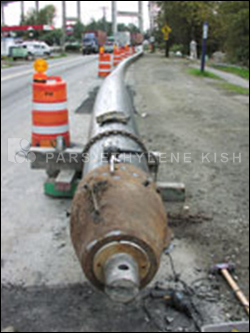
Archeologically Sensitive
The Native people of Canada or First Nations people actively promote environmental awareness and work to protect historical sites and even sacred areas throughout Canada. Because of the location of the River Road project, a registered archeologist as well as a local First Nations representative were required to supervise all excavations on the project.
O’Sullivan said, "Working with the First Nations people required that all of the excavation we did for launch and exit pits be raked and sifted for artifacts. If they saw something of interest while we were digging, we would remove the soil and take it to another location where it could be examined by the archeologist and First Nations representative."
According to O’Sullivan while artifacts like arrowheads were discovered on their portion of the project, human remains were discovered during the road construction portion of the project. He said, "Road construction crews discovered two sets of human remains in a burial site. This caused work to stop as the design of the project was revised to allow the remains to be left undisturbed. Those instances are taken quite seriously up here.
"As it relates to pipe bursting and trenchless construction however, I think it’s something that engineers and owners could take to the Native peoples and show them how we propose to replace the sewer line. Show them the methodology we intend to use in order to mitigate any damage to sensitive sites. It’s very positive and worked well for the River Road Project."
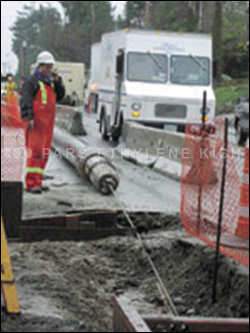
River Road Project
The sewer work, in terms of the total scope of the project, is taking place about one year before the road improvements are made. O’Sullivan explained, "The road improvement portion of the project is proceeding in sections. The first two sections of the road did not have any sewer work underneath it. The section of bursting we recently completed is now undergoing roadwork. Then, the sewer work we hope to do this year will undergo roadwork next year. It’s being done that way to manage traffic flow and to allow any excavation that we do to settle before road improvements are done."
The existing 375 mm (15-in.) diameter reinforced concrete (RCP) sewer was installed over 50 years ago and handles approximately 50 percent of the flow from the northern half of the city (approximately 25,000 residents). Subject to surcharging during wet conditions, the trunk was suffering from numerous areas of structural deterioration as well as massive tree root intrusion.
several factors made pipe bursting an ideal choice for this project. This is really a project where all the benefits of pipe bursting are evident. Growth in the area required the diameter of the main to be increased. Pipe bursting is the only trenchless method of replacement that allows for the upsizing of the original line. There were also numerous sub-utilities in the area, so the fact the new pipe would follow the path of old pipe was important, as was the reduction in excavation from the trenchless method. That also came into play when dealing with the heavy traffic in the area. Not to mention the archeological factors.
With the benefits of bursting apparent, O’Sullivan proceeded to plan out the project. He said, "We needed to replace approximately 800 m (2,600 ft.) of trunk main and perform some lateral work as well. We divided the bursting into eight different sections. Bursting lengths varied from 60 to 120 m (190 to 390 ft.) each. The sections would be upsized to 450 mm (18 in.) with one section upsized to 508 mm (20 in.). We had everything ready to go and were awaiting the arrival of Mike Schwager from TT Technologies. It was the second week of September."
On September 11, 2001, Schwager was preparing to make the trip north, across the US/Canadian border to provide on-site technical support for the bursting work about to begin in Delta. After the tragic events of that morning, all US borders were closed and the trip never took place.
O’Sullivan said, "This was the largest diameter bursting we had ever attempted. We anticipated the need for technical assistance. Looking back, I wore out the phone with Mr. Schwager about different aspects of the project. It was very helpful.
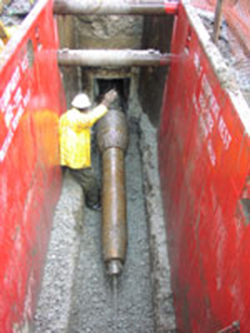
On The Job
Bursting began on September 13th. The crew faced tight working conditions along the River Road corridor, along with launch and exits pits that averaged 3 to 5 m (10 to 15 ft.) deep. Traffic, however, was the main concern. O’Sullivan said, "Traffic control was easily the most challenging part of the project. Traffic was horrendous and the manholes were located right along the white line on edge of the road. We actually moved the road over about a meter and a half to run traffic on the shoulder. Then we put up concrete barricades to work behind. It was very tight."
The PW Trenchless crew completed the first three runs with a straight barrel reversible Grundocrack Koloss, but the manholes were too small to facilitate easy tool removal. The switch was made to a rear expander configuration for the remaining bursts.
Schwager said, "When we began bursting in the late 1970s and early 1980s, straight barrel tools with front expanders were commonly used. They can be removed through manholes or reversed out through the newly installed pipe. Their effectiveness, however, is somewhat limited by soil conditions, length of run and host pipe material.
The rear expander configuration provides several key advantages. First, it allows the use of bentonite in conditions that warrant it. Second, the rear expander tool configuration means that a majority of the tool itself is actually in the pipe. This increases bursting power and assists in maintaining line and grade."
Bursting with the rear expander configured tool continued without incident. The 350-mm (14-in.) diameter Koloss was equipped with a 550-mm (22-in.) diameter rear expander. The PW Trenchless crew used a 10-ton constant tension Grundowinch to guide the tool through the host pipe. Bursting times ranged between 2 and 3 hours for each segment with soil conditions ranging from running sand to densely packed glacial till.
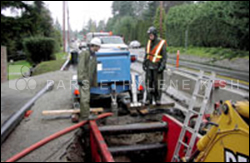
Bursting Results
The River Road sewer project marked a new level of pipe bursting capability for a contractor that already has a substantial amount of bursting experience. It was their longest bursting project to date as well as the largest diameter project. For O’Sullivan it’s a progression. He said, "We started bursting 1998 with a 101-mm (4-in.) diameter tool for doing laterals and we’ve worked our way up from there. We went to a 150-mm (6-in.) tool, then a 200-mm (8-in.) tool. Now we're working with the 350-mm (14-in.) Koloss tool with substantial upsizes like the River Road project. We’re definitely growing with the technology."
While the River Road project is a highlight for PW Trenchless it certainly won’t be their last. According to O’Sullivan, the company has several bursting projects lined up that will exceed the River Road project in terms of scope and complexity. O’Sullivan said he welcomes the challenge.
Source: Trenchless Technology International